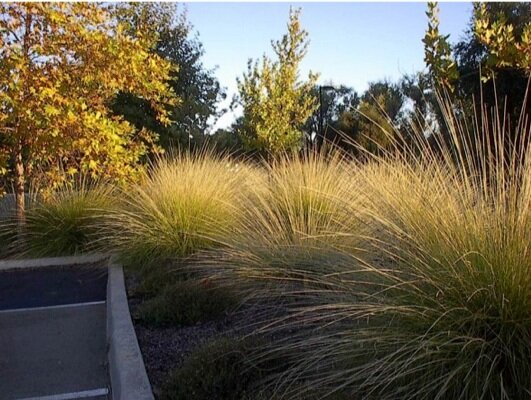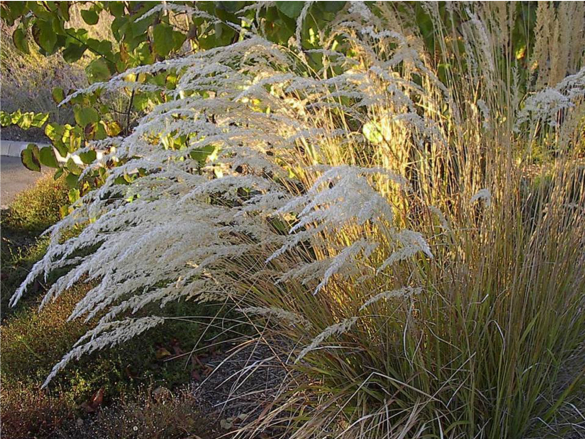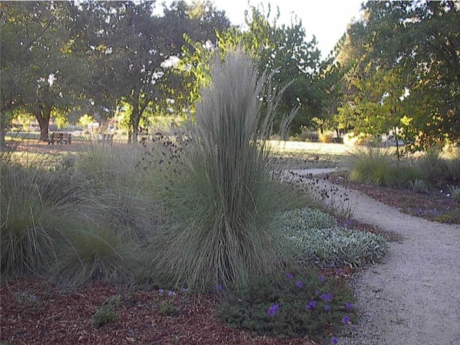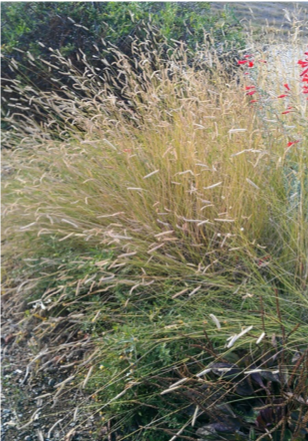Ornamental Grasses: Form, Movement and Light
We love ornamental grasses! They bring so much to a garden. One or more species in a garden highlights neighboring plants and brings added movement, light and interesting forms to what can otherwise be a largely static landscape.
One ornamental grass popular in modern garden design is Muhlenbergia rigens Deer Grass; a local California native grass with a fountain-like form that is beautiful as either a single specimen plant or in mass plantings.





Grasses add a multitude of forms to a garden: upright, weeping, flowing, mounding, and forms that conjure the term ‘architectural’. Ornamental grasses epitomize nature’s elegant architecture by bringing singular and long-lasting, kinetic forms to otherwise static landscapes. Grasses also possess the attribute of adding visual cohesion to a garden. The well-placed presence of grasses in the garden helps to bring disparate plants together. Grasses can do this by filling space between other plants without making the garden seem overly ‘busy’ because of their simple, graceful form.
Aside from their ornamental qualities, there aren’t any other types of plants in the cultivated garden easier to care for than ornamental grasses. They are highly disease and pest resistant and virtually carefree. Aside from a hard annual or biannual cutting back in early spring (when new growth begins) perennial ornamental grasses are the steadfast standard-bearers of the garden, carrying on while other perennials decline with colder weather.
Grasses at Turtle Bay
1. Austrostipa ramosissima Pillar of Smoke Grass
2. Bouteloua gracilis Blue Grama Grass, Mosquito Grass
3. Calamagrostis xacutiflora ‘Karl Foerster’ Feather Reed Grass
4. Festuca glauca 'Elijah Blue' Elijah Blue Fescue
5. Helictotrichon sempervirens Blue Oat Grass
6. Hakonechloa macra ‘Aureola’ Hakone Grass
7. Miscanthus sinensis ‘Adagio’ Adagio Maiden Grass
8. Miscanthus sinensis ‘Malepartus’ Malepartus Maiden Grass
9. Miscanthus sinensis ‘Morning Light’ Morning Light Maiden Grass
10. Miscanthus sinensis ‘Strictus’ Porcupine Grass
11. Miscanthus sinensis ‘Variegatus’ Variegated Maiden Grass
12. Miscanthus sinensis ‘Yaku Jima’ Yaku Jima Maiden Grass
13. Miscanthus transmorrisonensis Evergreen Maiden Grass
14. Muhlenbergia capillaris Pink Muhly Grass
15. Muhlenbergia lindheimeri Lindheimer’s Muhly
16. Muhlenbergia rigens Deer Grass
17. Nassella pulchra Purple Needle Grass
18. Nassella tenuissima Mexican Feather Grass
19. Pennisetum alopecuroides‘ Moudry’ Moudry Fountain Grass
20. Themeda trianda Kangaroo Grass
21. Schizachyrium scoparium Little Bluestem
22. Stipa gigantea Giant Feather Grass
Propagation
By division: Dividing clump-forming grasses is a straight-forward process. Clumping grasses may have significant root systems which require some force (e.g., a shovel) to divide. Running grasses are usually easier to divide at individual plantlets. Research individual grass species for specific propagation tips.
How to divide clump-forming grasses: in spring, dig outside the perimeter of plant 4-8” to preserve as many roots as possible; place clump either on the ground or potting table and divide grass crown (base of plant). Larger divisions will fill in faster than individual plantlets.
By seed: Many ornamental grass species are easy to propagate by seed in flats. Some species also reseed freely in well- watered or over-watered landscapes. Individual species should be researched for this trait as certain ornamental grasses can become invasive in overly watered areas.
We can appreciate ornamental grasses for their many months of visual interest throughout the year. Come see the many species of grasses growing all over the 300 acre Turtle Bay campus and at the Arboretum & Botanical Gardens Nursery.
Happy gardening from the horticulture staff at Turtle Bay!
Got questions or comments? You can email Turtle Bay’s horticulture department at gardens@turtlebay.org.
The beautiful McConnell Arboretum & Botanical Gardens are open year-round. The Nursery is open Fridays and Saturdays from 9:00 am to 1:00 pm.






